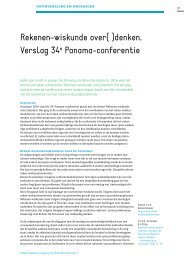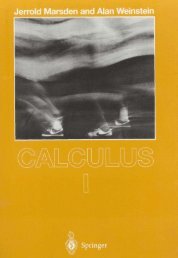You also want an ePaper? Increase the reach of your titles
YUMPU automatically turns print PDFs into web optimized ePapers that Google loves.
Analytisch/denken/en/probleemoplossen!!<br />
Het!gaat!hierbij!om!het!kiezen!van!een!probleemaanpak,!de!vaardigheid!om!het!probleem!te!kunnen!<br />
formuleren,!de!vaardigheid!om!het!probleem!te!kunnen!representeren!en!de!vaardigheid!om!<br />
oplossingsstrategieën!te!vinden!(Drijvers,!2011).!<br />
Polya!(1988)!heeft!heuristieken!beschreven!die!moeten!helpen!een!probleem!op!te!lossen.!<br />
Zie!onderstaand!kader.!!<br />
!<br />
1. UNDERSTANDING THE PROBLEM<br />
◦ First. You have to understand the problem.<br />
◦ What is the unknown What are the data What is the condition<br />
◦ Is it possible to satisfy the condition Is the condition sufficient to determine the unknown<br />
Or is it insufficient Or redundant Or contradictory<br />
◦ Draw a figure. Introduce suitable notation.<br />
◦ Separate the various parts of the condition. Can you write them down<br />
2. DEVISING A PLAN<br />
◦ Second. Find the connection between the data and the unknown. You may be obliged to<br />
consider auxiliary problems if an immediate connection cannot be found. You should<br />
obtain eventually a plan of the solution.<br />
◦ Have you seen it before Or have you seen the same problem in a slightly different form<br />
◦ Do you know a related problem Do you know a theorem that could be useful<br />
◦ Look at the unknown! And try to think of a familiar problem having the same or a similar<br />
unknown.<br />
◦ Here is a problem related to yours and solved before. Could you use it Could you use its<br />
result Could you use its method Should you introduce some auxiliary element in<br />
order to make its use possible<br />
◦ Could you restate the problem Could you restate it still differently Go back to definitions.<br />
◦ If you cannot solve the proposed problem try to solve first some related problem. Could<br />
you imagine a more accessible related problem A more general problem A more<br />
special problem An analogous problem Could you solve a part of the problem<br />
Keep only a part of the condition, drop the other part; how far is the unknown then<br />
determined, how can it vary Could you derive something useful from the data<br />
Could you think of other data appropriate to determine the unknown Could you<br />
change the unknown or data, or both if necessary, so that the new unknown and the<br />
new data are nearer to each other<br />
◦ Did you use all the data Did you use the whole condition Have you taken into account all<br />
essential notions involved in the problem<br />
3. CARRYING OUT THE PLAN<br />
◦ Third. Carry out your plan.<br />
◦ Carrying out your plan of the solution, check each step. Can you see clearly that the step is<br />
correct Can you prove that it is correct<br />
4. Looking Back<br />
◦ Fourth. Examine the solution obtained.<br />
◦ Can you check the result Can you check the argument<br />
◦ Can you derive the solution differently Can you see it at a glance<br />
Can you use the result, or the method, for some other problem<br />
Samenvatting!van!Polya’s!“How!to!Solve!it”!:!http://www.math.utah.edu/~pa/math/polya.html.!<br />
!<br />
!<br />
!<br />
!<br />
!<br />
Dit!materiaal!is!gemaakt!gedurende!de!!<br />
Leergang!Wiskunde!Delft,!voorjaar!2014!<br />
67!













